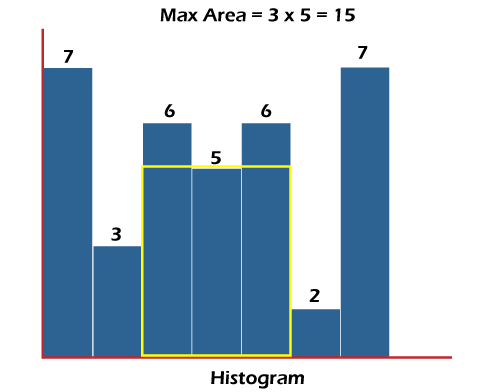Maximum Rectangular Area in a Histogram in JavaIn this section, we will see how one can compute the maximum rectangular area in the histogram. What is maximum rectangular area in the histogram?The maximum rectangle that has to be created should be made of continuous bars. For the sake of simplicity, we will assume that the width of each bar is 1. For example, for the following histogram that has 7 bars of the heights {7, 3, 6, 5, 6, 2, 7}, the maximum rectangular area, which is possible, is 15. The maximum area is highlighted in yellow color. 
Let's discuss the various approaches to solve this problem. Naïve ApproachIn this approach, we will consider each bar one by one as the starting point, and from the starting point, we will compute the rectangular area each time by taking the next coming bar one by one. Every time we compute the rectangular area, we compare it with the current maximum area (initially, the maximum area is initialized with 0). FileName: LargestRectArea.java Output: The maximum rectangular area is: 15 Time Complexity: In the above program, we have used the nested for-loops of degree 2. Therefore, the total complexity of the above program is O(n2), where n is the total number of elements present in the input array. Divide and Conquer ApproachThe concept is to find the index of a value in the input array that is minimum. Once we have found the index of the value that is minimum, the maximum area is the maximum of the following three values.
Observe the following program. Output: The maximum rectangular area is: 15 Time Complexity: In the above program, the time complexity is dependent on two things: one is the segment tree, and the second is finding the maximum rectangular area. The time complexity consumed in building the segment tree is O(n) and for finding the maximum rectangular area, the time complexity is O(log(n)). Thus, the time complexity becomes O(n) + O(n * log(n)), and asymptotically the time complexity becomes O(n * log(n)), where n is the total number of elements present in the input array. If we compare the above two programs, we find that the latter one is more optimized as it takes less time to solve the problem. However, we can even optimize it furthermore. Let's see it in the following approach. Approach: Using StackLet's see the algorithm for finding the rectangular area using stack. Step 1: Create a stack for pushing and popping elements. Step 2: Begin from the first bar, and perform the following task for every bar "histArr[j]" where 'j' varies from 0 to s - 1.
Step 3: If the stack is containing some bars, pop all the bars one by one from the stack and repeat step 2(ii) for every removed bar. FileName: LargestRectArea2.java Output: The maximum rectangular area is: 15 By Using Auxiliary ArraysAnother approach is to find the previous smaller and the next smaller bar, for every bar present in the histogram, and it will be achieved using two auxiliary arrays. See the following algorithm. Step 1: First, we take two auxiliary arrays leftSmaller[] and rightSmaller[] and initialize them with a negative number and n, respectively. Step 2: For each element, we keep the index of the next smaller and the previous smaller element in rightSmaller[] and leftSmaller[] arrays, respectively. It takes O(n) time. Step 3: For each bar, we compute the area by taking the jth bar as the shortest in the range leftSmaller[j] and rightSmaller[j] and multiplying it with the difference of leftSmaller[j] and rightSmaller[j]. Step 4: The maximum area can be computed by comparing the area for each bar. The area for the different bars is computed in step 3. FileName: LargestRectArea3.java Output: The maximum rectangular area is: 15 Time Complexity: The time complexity of the last two approaches is O(n), where n is the total number of elements present in the array.
Next TopicPolygonal Number in Java
|
 For Videos Join Our Youtube Channel: Join Now
For Videos Join Our Youtube Channel: Join Now
Feedback
- Send your Feedback to [email protected]
Help Others, Please Share










